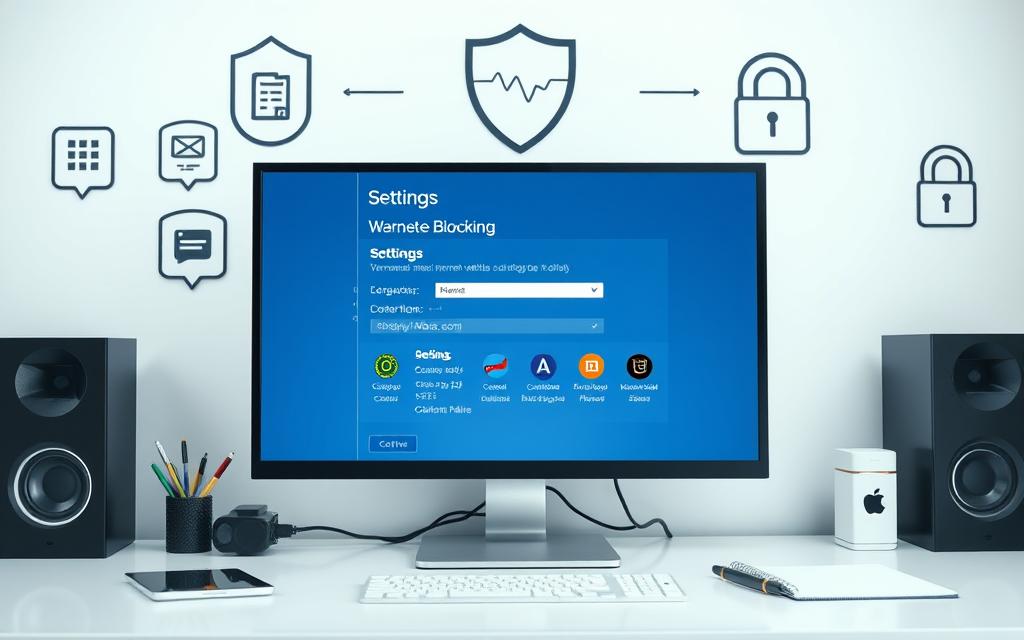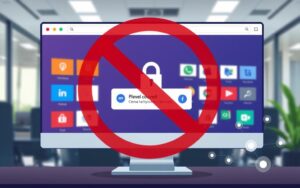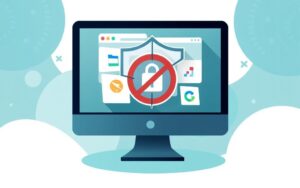Table of Contents
In today’s world, it’s vital to block unwanted websites. This ensures a safer browsing experience. This guide shows you how to block unwanted sites in my PC. We cover various website blocking methods to suit different needs.
Options include easy-to-use browser extensions like BlockSite, with over three million downloads. There are also parental controls in your operating system. This guide will give you the tools to manage online content effectively. Blocking bad sites boosts safety and encourages better internet habits.
Understanding the Need to Block Unwanted Websites
In our digital world, it’s key to know why we block bad websites to stay safe online. Browsing without filters can lead us to unsafe online content. This is especially risky for kids who might not know the dangers. Going online without limits can expose us to scary stuff.
This includes seeing things we shouldn’t, falling into scams, and even getting malware on our devices.
Risks Associated with Unfiltered Browsing
The web is full of information, but also dangers. Browsing without filters can easily take us to risky sites. This can lead to several problems:
- Exposure to explicit/graphic material
- Involvement in scams and frauds
- Maliware installation on devices
- Security breaches affecting personal data
Benefits of Blocking Inappropriate Content
Blocking bad websites has many good points. The benefits of blocking websites go beyond just filtering. They help make the internet a better place for everyone. Some important benefits are:
- Protection from harmful content
- Improved focus for studies and work
- Increased productivity in various tasks
- A structured approach to managing family safety online
Taking action to block bad sites helps families browse safer. It’s crucial to build good online habits and be more aware. This leads to a safer digital environment for us all.
How to Block Unwanted Sites in My PC
It’s crucial to block unwanted sites to keep browsing safe. Many ways are there to do this, each with different control levels. It helps to know about these methods to pick the best one for your needs.
Overview of Various Methods
There are several ways to block unwanted sites. You can use in-built features, browser add-ons, or solutions that work at the network level. Here are the main methods:
- Microsoft Family Safety: Great for families wanting to ensure safe online habits.
- Browser Extensions: Tools like BlockSite make filtering websites easy.
- Editing the Hosts File: This lets you limit access on your system for a solid fix.
- Parental Controls: These are built-in options that help parents monitor their kids’ internet use.

Choosing the Right Method for Your Needs
Choosing how to block sites depends on what you need. Think about:
- Age of Users: Tighter restrictions for young ones, easier ones for adults.
- Technological Expertise: Pick a method that matches how good you are with tech.
- Monitoring Needs: Some may want to keep an eye on web use.
Thinking about these things will make sure you choose a method that fits well. It will keep your online world safe and suited to you.
Using Microsoft Family Safety to Block Websites
Microsoft Family Safety is a strong tool for families online. It lets adults make a safe online space with features for monitoring and restrictions. Learning to set up a Microsoft account for family use is key to make the most of these options.
Creating a Microsoft Account for Family Members
To start with Microsoft Family Safety, you need to create a Microsoft account for every family member. Go to the account settings to add people to your family group. This helps in keeping track of internet use and makes browsing safer for everyone.
Setting Content Restrictions for Child Accounts
Once accounts are made, parents can set limits for their children’s accounts. By logging into their Microsoft account and going to “Your Family,” they can block bad websites by entering their URLs. This keeps kids away from dangerous content online.
Monitoring and Reporting Online Activity
Monitoring what kids do online is another important feature of Microsoft Family Safety. Parents can see which apps and sites their children use. This helps parents know what their kids are into and promotes safer internet habits. Regularly checking this info helps keep a secure online space for the family.
Blocking Websites with Browser Extensions
Browser extensions for blocking sites are quick and simple for controlling what content you see online. There are many options that let you tailor your web experience. A top choice is BlockSite, which has over three million downloads. People like it for its easy BlockSite setup.
Popular Extensions for Google Chrome
For Google Chrome, there are many safety extensions. BlockSite stands out with a 4.4 rating from nearly 30,000 reviews. The free version limits you to three blocked sites. For unlimited blocking and extra features like password protection, the premium version costs $3.99 a month. Other well-regarded extensions include:
- StayFree – Website Blocker & Web Analytics: Has a 4.8-star rating from 1.8K reviews.
- Incognito Blocker: Rated 4.7 stars from 78 reviews.
- FocusGuard – Free Site Blocker: Has a 4.5-star rating from 2K users.
Setting Up BlockSite for Enhanced Control
To start with BlockSite, you first download it from the Chrome Web Store. After installing, you can add sites to your block list. You can even schedule blocking and use focus modes. These features help you stay on track online, making it great for improving browsing focus.
Other Recommended Extensions for Various Browsers
Aside from Google Chrome, there are site-blocking extensions for Firefox and Microsoft Edge too. Each browser has unique tools for managing content. By looking into these options, you might find the perfect solution for your needs and browsing habits.
Editing the Hosts File to Restrict Website Access
The hosts file is key for linking hostnames to IP addresses. By editing it, users can block access to certain websites. Each operating system has its way of modifying this file, ensuring safe web browsing.
Steps to Edit Hosts File on Windows
In Windows, the hosts file is located at C:\Windows\System32\drivers\etc. To edit, open a text editor as an administrator. Here, you can add unwanted domain names next to 127.0.0.1. Once saved, these sites won’t be accessible anymore.
Editing Hosts File on macOS
MacOS users follow a similar process to Windows. Open Terminal, then type sudo nano /etc/hosts to begin editing. You need the right permissions to make changes. Once edited, saving the file will block the selected sites.
Precautions When Modifying System Files
Before editing the hosts file, it’s smart to back it up. This avoids problems if mistakes are made. Make sure to check file permissions too. These steps ensure your system runs smoothly while blocking unwanted websites.
Using Parental Controls for Internet Management
Parental controls are vital for keeping children safe online. They help families avoid unsuitable content easily. There are different ways to set these controls, like using Windows 10 parental settings or Google Family Link.
Setting up Parental Controls on Windows 10
Windows 10 has built-in parental controls that parents can set up quickly. By creating a special child account, parents can manage how much screen time their child have. They can also block certain websites. This helps in keeping kids away from harmful content and safe online.
Implementing Google Family Link for Filtering
Google Family Link is another great tool for keeping kids safe. With it, parents can control their child’s Google account and limit access on Google Chrome. This way, parents decide which websites their children can visit. To learn more about setting up custom filters, reading resources like this guide on blocking websites will help.
Conclusion
This guide has shown ways to stop unwanted websites, making the internet safer, especially for kids. It has introduced parental controls like Microsoft Family Safety and Google Family Link. It also talked about browser extensions like BlockSite to easily block sites.
Using these internet safety methods is very important. They help keep away bad content and distractions. By understanding how to block sites, you can pick the best option for you. This keeps the internet safe for everyone.
Putting these ideas into action keeps users safe and helps them stay focused online. As the internet changes, being careful about online safety is key. This guide aims to help you block unwanted sites effectively.
FAQ
What are the risks associated with unfiltered browsing?
Unfiltered internet access can lead kids to see harmful stuff, like inappropriate images, scams, and viruses. This might risk security and personal data.
How can blocking websites benefit my family’s online safety?
Blocking sites keeps everyone safe from dangerous online material. It creates a safe web space and improves concentration. It also helps parents control their kids’ internet use and adds extra security.
What are the different methods to block unwanted websites?
Different ways to block sites include Microsoft Family Safety, browser add-ons, changing the hosts file, and using parental controls. Each approach suits different needs and skill levels.
How do I create a Microsoft account for my family members?
To use Microsoft Family Safety, create Microsoft accounts for family members. Go to account settings and add them one by one.
How can I set content restrictions for child accounts?
After making accounts, parents can log in, head to “Your Family,” and start blocking bad sites by typing their URLs.
What extensions are recommended for blocking websites in Google Chrome?
Extensions like BlockSite make it easy to block unwanted sites in Chrome. They offer simple ways to change browsing settings.
How do I edit the hosts file on my Windows PC?
To change the hosts file in Windows, go to `C:\Windows\System32\drivers\etc`. Use a text editor with admin rights to block sites by adding their names with the localhost IP (127.0.0.1).
Can I set up parental controls on Windows 10?
Yes, Windows 10 has parental controls in the account settings. By setting up a child account, you can limit screen time, block sites, and keep track of web use.
How do I use Google Family Link for my child’s internet safety?
Google Family Link helps you make the internet safer for your child. Install the app, access your child’s account, and manage website filters as needed.










1 comment
[…] How to Block Unwanted Websites on Your PC: A… […]